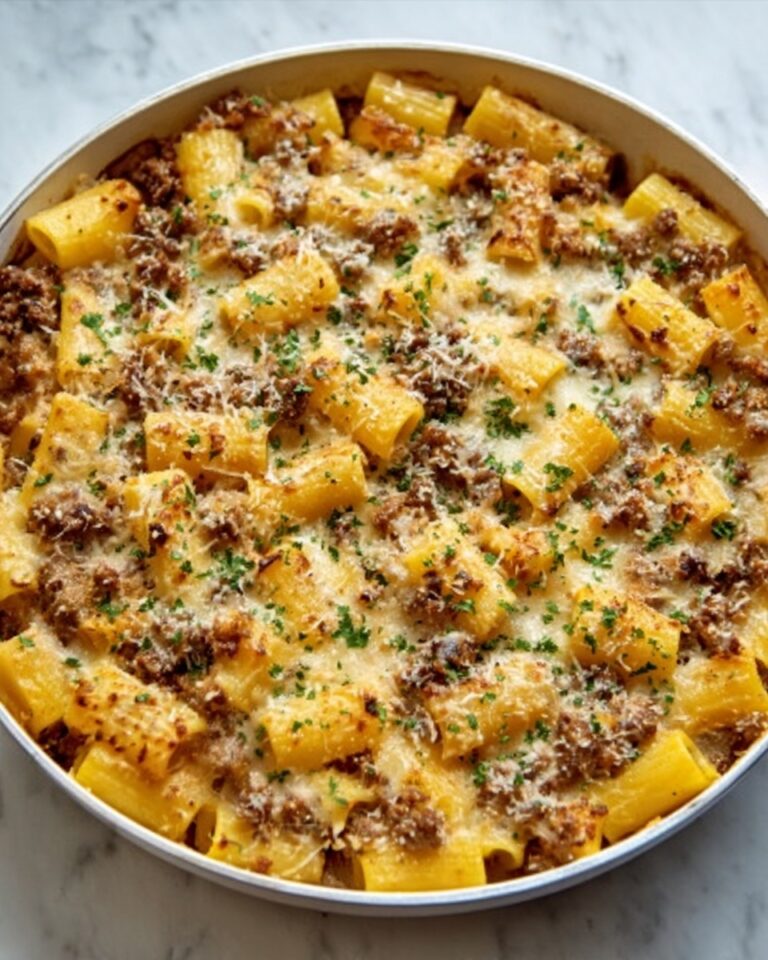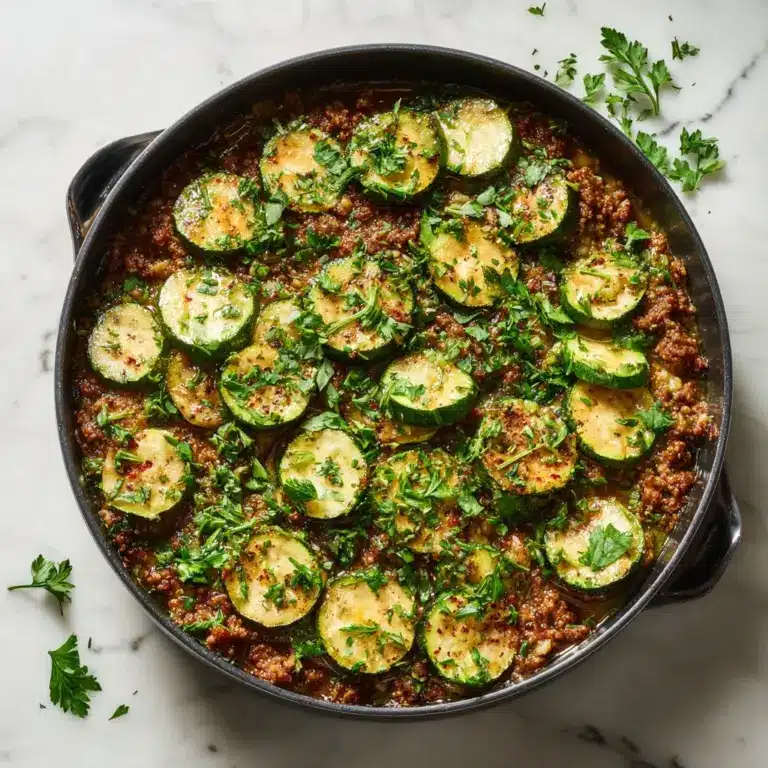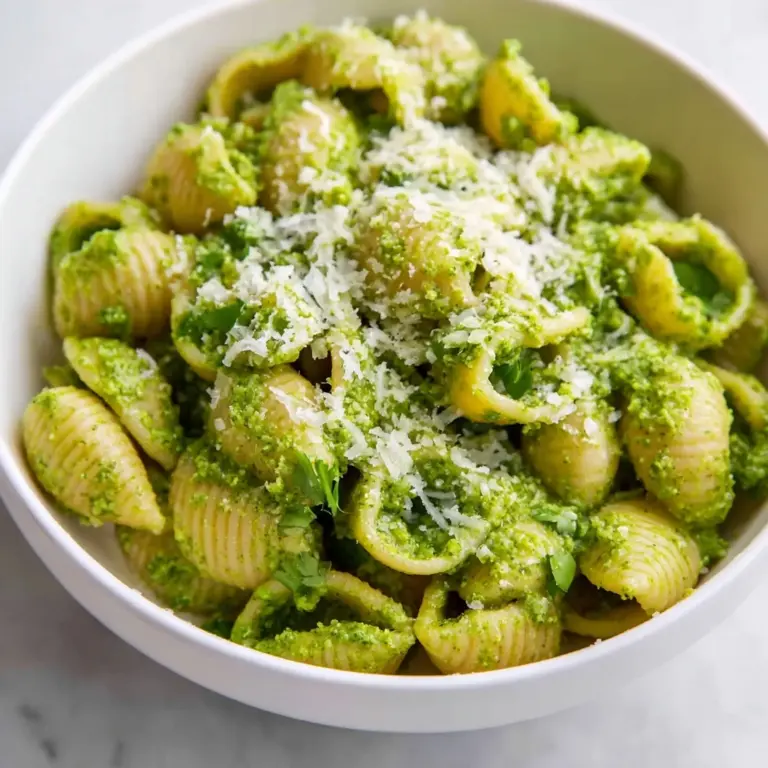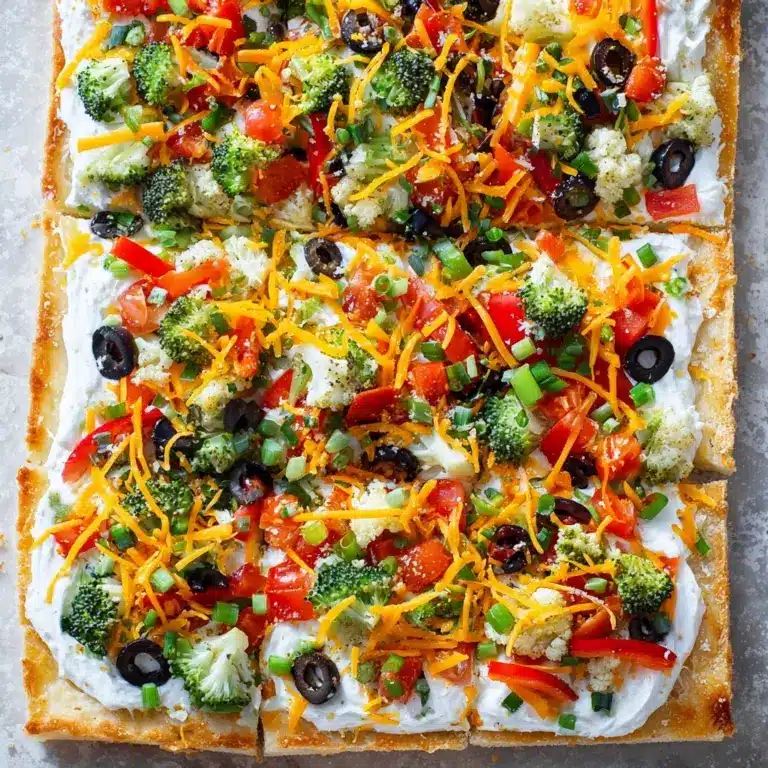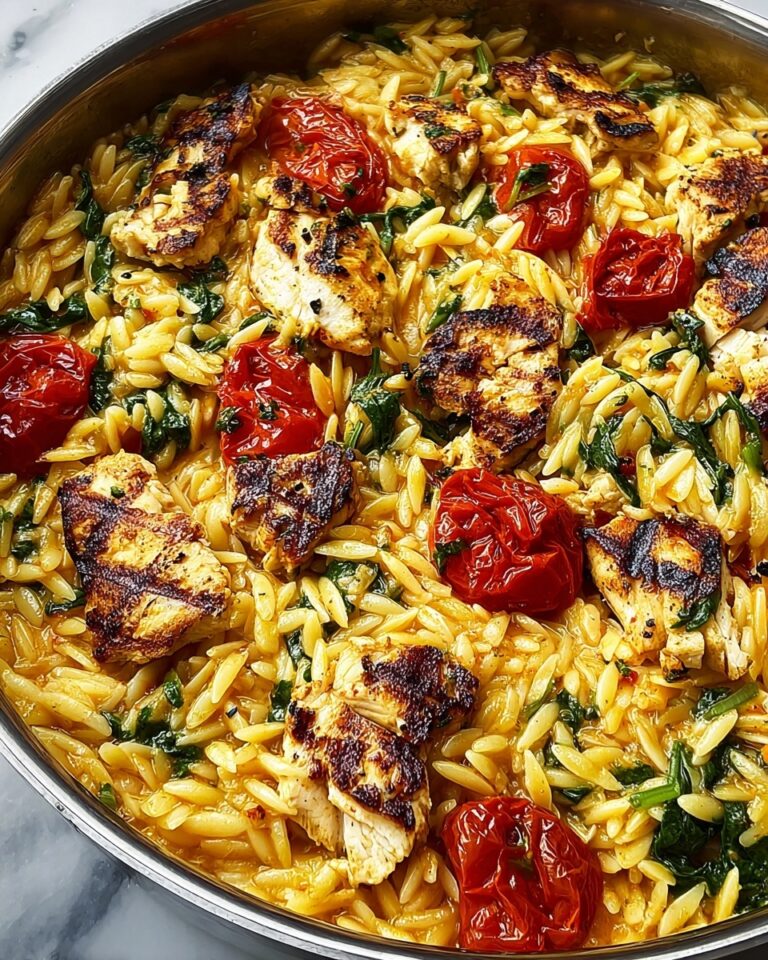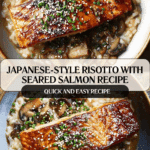Japanese Style Risotto with Seared Salmon Recipe
If you’re craving a dish that perfectly balances comforting creaminess with bold, savory flavors, this Japanese Style Risotto with Seared Salmon is here to delight every sense. Imagine tender sushi rice cooked slowly to a silky texture, infused with earthy shiitake mushrooms and a subtle hint of miso, paired with perfectly seared salmon that’s juicy on the inside with a crisp exterior. This is a bowl that transforms everyday ingredients into a refined, soul-satisfying meal, inviting you to savor every bite as if it were a warm, friendly hug on a plate.
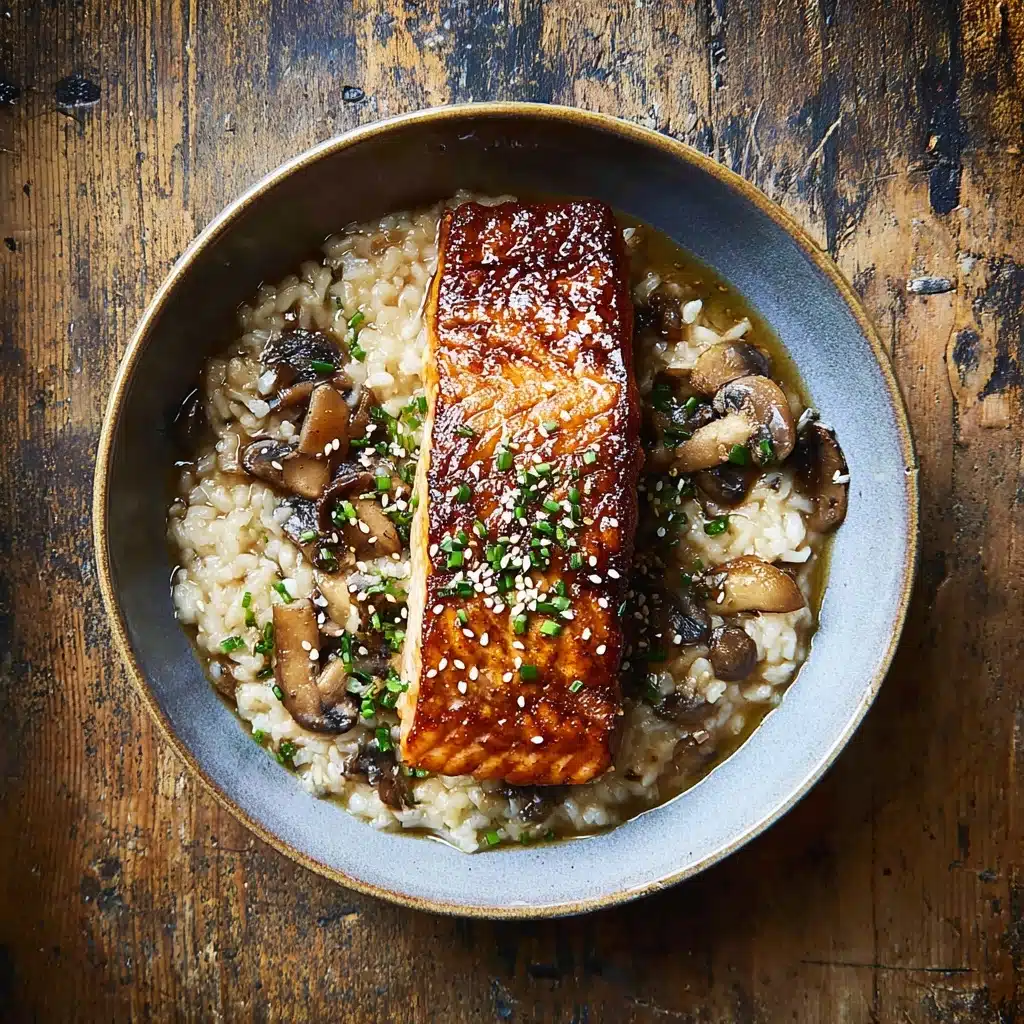
Ingredients You’ll Need
This recipe keeps things beautifully simple, relying on a handful of fresh, essential ingredients that each bring their own unique contribution to flavor, texture, and color. From the umami-packed shiitakes to the aromatic garlic and crisp celery, everything plays a part in crafting that irresistible Japanese Style Risotto with Seared Salmon.
- 3 tbsp olive oil (divided): This is your cooking foundation, helping to develop flavor and texture in both the risotto and salmon.
- 10.5 ounces shiitakes (torn into pieces): Adds an earthy, meaty depth that complements the rice beautifully.
- 1 tbsp low sodium soy sauce: A savory boost that enhances the umami character without overpowering.
- 1 small yellow onion (diced): Provides sweetness and a tender bite once sautéed gently with garlic and celery.
- 1 celery stalk (diced): Adds a fresh, crisp texture to balance the dish.
- 1 garlic clove (minced): Brings aromatic warmth and complexity.
- 1 cup rice (like sushi rice or Arborio): The star base, responsible for that creamy risotto texture.
- ¼ cup dry white wine (or sake): Helps deglaze the pan, adding acidity and subtle complexity.
- 5 cups hot chicken broth: The liquid that cooks the rice and infuses savory richness.
- 1 tbsp white miso paste: Adds a gentle fermented depth and vibrant umami punch.
- Black pepper (for serving): For just the right amount of spice when you plate it.
- Chives (for serving): Fresh, green herbaceous lift in both color and flavor.
- Sesame seeds (for serving): Toasted or raw, they add a subtle nutty crunch and visual appeal.
- 5 tbsp low sodium soy sauce (for salmon marinade): Soaks into the salmon, ensuring a savory caramelized finish.
- 1 tbsp dry white wine (for salmon marinade): Balances the sweetness and adds brightness to the marinade.
- 1 tsp brown sugar (for salmon marinade): Helps create a delicate glaze when searing the salmon.
- 4 skinless salmon fillets: The luxurious, tender protein centerpiece.
- 1 tbsp olive oil (for searing): Assists in crisping the salmon skinless but flavorful.
- 1 tbsp unsalted butter (for searing): Adds richness and aids in achieving that perfect golden sear.
How to Make Japanese Style Risotto with Seared Salmon
Step 1: Marinate the Salmon
Start by whisking together soy sauce, white wine, and brown sugar to create a simple marinade bursting with umami and a touch of sweetness. Lay your salmon fillets in a shallow dish and coat both sides thoroughly with this mixture. Set the salmon aside while you prepare the risotto so it takes on those beautiful flavors that will elevate your dish to another level.
Step 2: Prep Your Vegetables
While the salmon marinates, tear those shiitakes into bite-sized pieces, finely dice the celery stalk, mince the garlic, and dice the yellow onion. This prep work ensures a harmonious blend of textures and flavors in the risotto, giving you layers of savory aroma and gentle crunch in every spoonful.
Step 3: Sauté the Shiitakes
Heat 1 tablespoon of olive oil in a heavy-bottomed skillet over high heat and toss in your shiitakes. Cook them until they release their juices and begin to brown, resulting in that rich concentrated mushroom flavor. Add another tablespoon of oil and a splash of soy sauce to deepen their savory profile, cooking just for another minute before removing them from the pan.
Step 4: Build Your Risotto Base
Lower the heat to medium low and add one more tablespoon of oil to the same pan. Stir in your diced celery, onion, and garlic, cooking for about two minutes until fragrant and just softened. Add the rice and toast it gently for a minute until it starts to shine and smell nutty. Then deglaze the pan with white wine, letting it simmer while you scrape up those delicious brown bits stuck to the bottom—this little step makes all the flavor difference.
Step 5: Simmer Your Risotto
Start adding hot chicken broth in ladlefuls—two at a time—stirring frequently. Wait until most of that broth is absorbed before adding more. Continue this process until the rice is tender yet still slightly firm to the bite, about 15 minutes. You might not need all the broth; the key is getting that creamy texture without overcooking. Toss in your sautéed shiitakes for that earthy flair, then dissolve the white miso in a bit of hot broth and stir it in. Let everything simmer together for five more minutes, adding more broth if you want it silkier.
Step 6: Sear the Salmon
While the risotto finishes, heat olive oil and butter together in a nonstick skillet over medium-high heat. Place your marinated salmon fillets in the pan and sear them for about four minutes per side until the exterior is beautifully caramelized and golden, while the interior remains tender and juicy. This contrast of textures and flavors is what makes this dish truly unforgettable.
Step 7: Plate and Serve
Finally, spoon your luscious risotto onto plates and lay the seared salmon fillets gently on top. Garnish with a sprinkle of freshly cracked black pepper, chopped chives, and sesame seeds to add freshness, color, and a slight crunch. Now, dig in and enjoy the magic you’ve created with this Japanese Style Risotto with Seared Salmon!
How to Serve Japanese Style Risotto with Seared Salmon
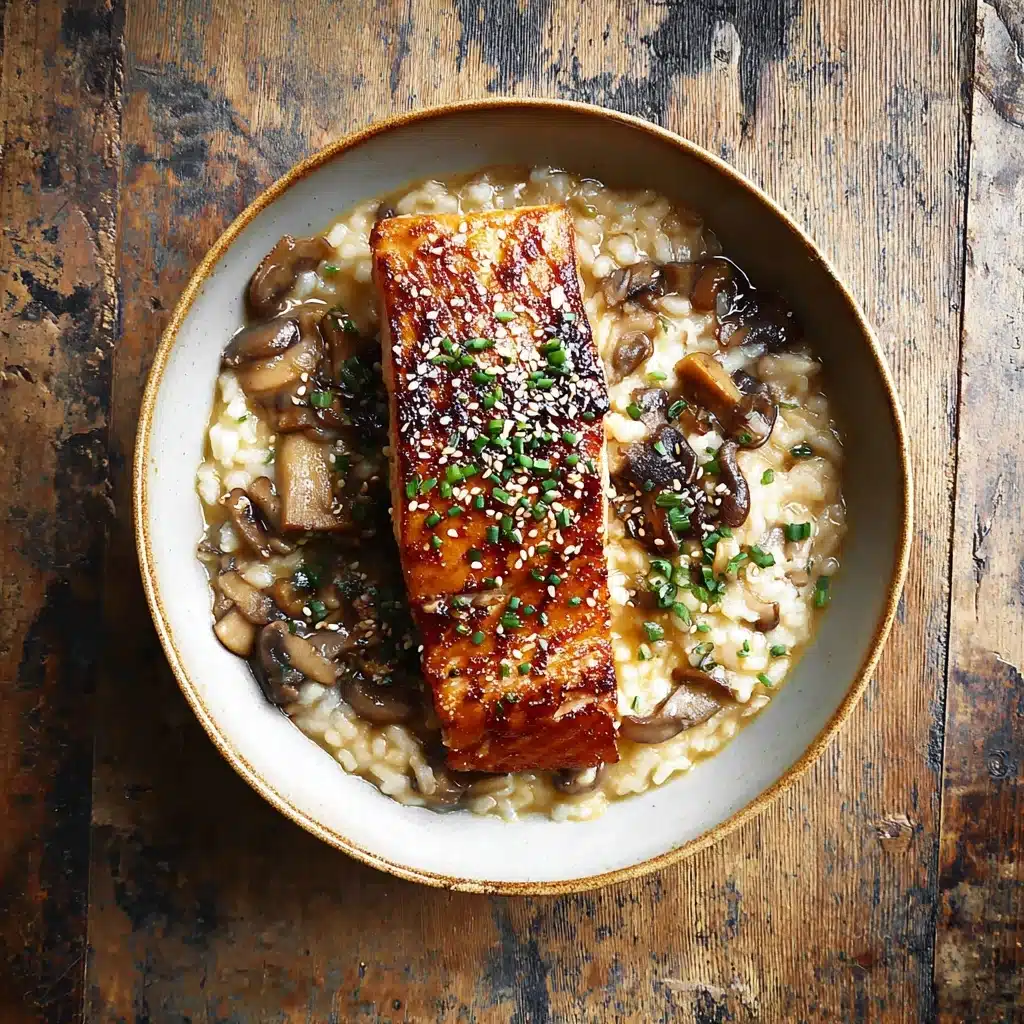
Garnishes
Fresh chives bring a pop of color and mild oniony brightness, while sesame seeds add subtle nuttiness and a pleasing crunch that complements the richness of the dish. A final crack of black pepper balances the flavors with a gentle heat, tying the entire dish together beautifully.
Side Dishes
This dish is hearty enough to hold its own, but if you want to round out the meal, consider a simple cucumber salad dressed in rice vinegar and sesame oil or a light miso soup to echo the Japanese flavors without overwhelming the palate. A side of steamed or sautéed greens like bok choy or spinach complements the richness perfectly.
Creative Ways to Present
For a stunning presentation, serve the risotto in shallow bowls with the salmon fillet carefully placed at an angle on top. A drizzle of soy glaze or a sprinkle of toasted nori strips can add a touch of elegance and extra flavor. You could also plate the risotto with a quenelle shape or use a ring mold for a refined touch when entertaining guests.
Make Ahead and Storage
Storing Leftovers
Once cooled, store leftover Japanese Style Risotto with Seared Salmon in airtight containers in the refrigerator. The risotto will keep well for up to 2 days. Keep the salmon separate if possible to maintain the best texture; salmon can absorb moisture and become less crisp when stored together with the rice.
Freezing
Risotto doesn’t freeze as well due to its creamy texture, but if necessary, freeze the rice portion alone in a freezer-safe container for up to a month. Salmon should ideally be consumed fresh but can be frozen raw prior to cooking. Avoid freezing salmon once it’s been seared to preserve its texture and flavor.
Reheating
Reheat risotto gently on the stovetop over low heat, stirring often and adding a splash of broth or water to bring back creaminess. Reheat salmon in a low oven or in a pan covered loosely with foil to avoid drying it out. This approach keeps the flavors fresh and the textures enjoyable.
FAQs
Can I use other types of mushrooms for this risotto?
Absolutely! While shiitakes add a unique earthiness, other mushrooms like cremini or oyster mushrooms work wonderfully and bring their own mild flavors to the dish.
Is it necessary to use white miso paste?
White miso adds a subtle savory depth without overpowering the risotto. If you don’t have it, you can omit or substitute with a small amount of yellow miso, but avoid stronger misos as they can dominate the dish.
Can I substitute the chicken broth with vegetable broth?
Yes, vegetable broth is a great vegetarian-friendly alternative and will still provide the savory liquid needed to cook the rice perfectly.
What if I don’t have Arborio or sushi rice?
If you can’t find these, try short-grain rice varieties that absorb liquid well and develop a creamy texture. Long-grain rice won’t yield the same risotto creaminess.
How can I tell when the salmon is perfectly cooked?
Look for an opaque color and a slight flake when gently pressed with a fork. The exterior should be crisp and golden. Cooking times may vary slightly depending on thickness, but four minutes per side is a reliable guide.
Final Thoughts
This Japanese Style Risotto with Seared Salmon is a recipe that truly shines with simplicity and care, rewarding you with layers of comforting flavors and textures that feel both special and nurturing. Whether you’re cooking for a weeknight treat or a dinner party centerpiece, give this recipe a try—you might just discover your new favorite way to enjoy salmon and risotto together.
Print
Japanese Style Risotto with Seared Salmon Recipe
- Total Time: 45 minutes
- Yield: 4 servings 1x
- Diet: Halal
Description
This Japanese Style Risotto with Seared Salmon combines the creamy texture of classic Italian risotto with delicate Japanese flavors, highlighted by shiitake mushrooms, miso paste, and a soy-based marinated salmon. The result is a comforting and elegant dish perfect for a refined weeknight dinner or special occasion.
Ingredients
For the Risotto
- 3 tbsp olive oil (divided)
- 10.5 ounces shiitake mushrooms (torn into pieces)
- 1 tbsp low sodium soy sauce
- 1 small yellow onion (diced)
- 1 celery stalk (diced)
- 1 garlic clove (minced)
- 1 cup rice (like sushi rice or Arborio)
- ¼ cup dry white wine (or sake)
- 5 cups hot chicken broth
- 1 tbsp white miso paste
For the Salmon Marinade
- 5 tbsp low sodium soy sauce
- 1 tbsp dry white wine
- 1 tsp brown sugar
For the Salmon and Garnishes
- 4 skinless salmon fillets
- 1 tbsp olive oil
- 1 tbsp unsalted butter
- Black pepper (for serving)
- Chives (for serving)
- Sesame seeds (for serving)
Instructions
- Marinate the Salmon: In a shallow dish, combine 5 tbsp low sodium soy sauce, 1 tbsp dry white wine, and 1 tsp brown sugar. Place the salmon fillets in the marinade and coat both sides well. Set aside to marinate while preparing the other ingredients.
- Prepare Ingredients: Tear the shiitake mushrooms into small pieces. Finely dice the celery stalk and yellow onion. Mince the garlic clove carefully to ensure even flavor distribution.
- Sauté the Shiitakes: Heat 1 tbsp olive oil over high heat in a heavy-bottomed pot or skillet. Add the torn shiitake mushrooms and cook until they release their moisture. Add another tablespoon of olive oil and continue cooking until mushrooms begin to brown. Stir in 1 tbsp low sodium soy sauce and cook for an additional minute. Remove the mushrooms from the skillet and set aside.
- Cook the Aromatics and Toast Rice: Reduce the heat to medium-low and add 1 tbsp olive oil to the same pot. Add diced celery, onion, and minced garlic. Cook for about 2 minutes until fragrant and softened. Add the rice and toast for 1 minute to enhance its flavor.
- Deglaze and Begin Simmering: Pour in ¼ cup dry white wine (or sake) to deglaze the pan, scraping up any browned bits with a wooden spoon. Simmer for 2 minutes until the liquid has mostly evaporated.
- Gradually Add Broth: Add 2 ladles (about 1 cup) of hot chicken broth at a time, stirring frequently. Allow the broth to almost completely absorb before adding the next 2 ladles. Continue this process until the rice is almost al dente, about 15 minutes. Note that you may not use all of the broth.
- Finish Risotto with Mushrooms and Miso: Stir in the sautéed shiitake mushrooms. Dissolve 1 tbsp white miso paste with 2 tbsp hot broth in a small bowl, then add to the risotto. Simmer for about 5 more minutes, adding more broth if needed to reach a creamy, tender consistency.
- Sear the Salmon: While the risotto simmers, heat 1 tbsp olive oil and 1 tbsp unsalted butter over medium-high heat in a nonstick skillet. Remove the salmon from marinade, letting excess drip off, then sear fillets for about 4 minutes on each side until nicely browned and cooked through.
- Serve: Plate the creamy risotto and top each serving with a seared salmon fillet. Garnish with freshly ground black pepper, chopped chives, and a sprinkle of sesame seeds. Serve immediately and enjoy!
Notes
- Use sushi rice or Arborio rice for the best creamy risotto texture.
- To make this recipe vegetarian, substitute chicken broth with vegetable broth and omit the salmon.
- You can replace white wine with sake for more authentic Japanese flavor.
- Adjust soy sauce and salt levels based on your taste preference and dietary restrictions.
- Make sure the chicken broth is hot when adding to the rice to maintain cooking temperature and texture.
- If shiitake mushrooms are unavailable, you can substitute with cremini or portobello mushrooms.
- Prep Time: 15 minutes
- Cook Time: 30 minutes
- Category: Main Course
- Method: Sautéing, Simmering, Searing
- Cuisine: Japanese-Italian Fusion
Nutrition
- Serving Size: 1 plate with one salmon fillet and risotto
- Calories: 520 kcal
- Sugar: 4 g
- Sodium: 650 mg
- Fat: 22 g
- Saturated Fat: 5 g
- Unsaturated Fat: 15 g
- Trans Fat: 0 g
- Carbohydrates: 45 g
- Fiber: 3 g
- Protein: 35 g
- Cholesterol: 75 mg
Keywords: Japanese risotto, seared salmon, shiitake mushrooms, miso risotto, gluten free, seafood risotto, Japanese cuisine, healthy dinner

